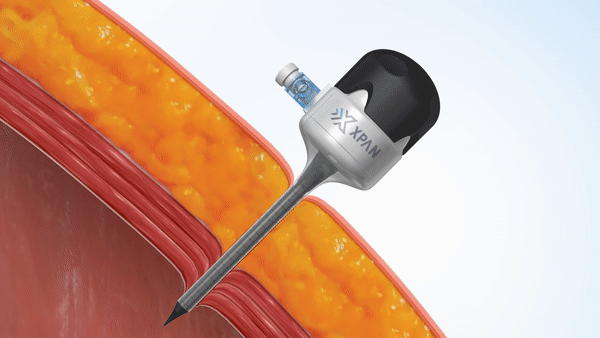
disrupting a 30-year old fundamental technology in Minimally Invasive Surgery
ONE TROCAR, THREE SIZES, COUNTLESS ADVANTAGES

Xpan aspires to provide the maximum safety for patients and the utmost flexibility, reliability and cost-effectiveness for surgeons & hospitals. The Xpan® Universal Trocar System is a full spectrum solution which uses patented expansion technology to accommodate instruments ranging from 3mm to 12mm.
A WIN FOR PATIENTS, PROVIDERS, & HOSPITALS
REDUCE MORBIDITY FOR
PATIENTS
INCREASE EFFICIENCY FOR PROVIDERS
IMPROVE COST EFFECTIVENESS FOR HOSPITALS

Xpan® utilizes radial dilation, which has been shown to reduce wound size and improve post operative recovery 1

Xpan® offers superior anti-slippage performance 2, reduced risk of accidental sheath penetration 3, and radial dilation which reduces need for fascial closure 4,5

Xpan® delivers personalized medicine, achieves standardization through a universal product, and uses radial dilation to reduce OR
time 6
SEE HOW IT WORKS
References:
1. Bhoyrul, S., Mori, T., & Way, L. W. (1996). Radially expanding dilatation. A superior method of laparoscopic trocar access. Surgical endoscopy, 10(7), 775–778. https://doi.org/10.1007/s004649900155
2. In benchtop testing on porcine models comparing retention forces, XP1075-01 had higher retention forces (9 N) than the MiniStep MS100703 (6N), XP1075-01 expanded with XP1076-01 had higher retention forces (47 N) than Applied Medical CTF01 (19 N) and VersaStep VS101005 (12 N), and XP1075-01 expanded with XP1077-01 had higher retention forces (50 N) than Applied Medical CTF71 (31 N) and VersaStep VS101011P (47 N). (TR5166).
3. In benchtop testing comparing angled entry of obturators during expansion, XP1075-01 had no sheath penetration when expanded with XP106-01 at angles from 10 to 30 degrees, while VersaStep VS101005 had sheath penetration when expanded at an angle of 15 degrees, and Step S101005 had sheath penetration when the obturator was at angles of 25 degrees. (TR5168).
4. Bhoyrul, S., Payne, J., Steffes, B., Swanstrom, L., & Way, L. W. (2000). A randomized prospective study of radially expanding trocars in laparoscopic surgery. Journal of gastrointestinal surgery: official journal of the Society for Surgery of the Alimentary Tract, 4(4), 392–397. https://doi.org/10.1016/s1091-255x(00)80018-9
5. Petersen, Rebecca & Demaria, Eric & Lautz, David & Mikami, Dean & Needleman, Bradley & Pryor, Aurora. (2010). M1665 Radial Dilating Trocar System is Associated With a Low Incidence of Port Site Hernias Among Patients Undergoing Laparoscopic Roux-en-Y Gastric Bypass Surgery. Gastroenterology. DOI: http://dx.doi.org/10.1016/S0016-5085(10)64054-1
6. J. R. Feste, B. Bojahr and D. J. Turner, “Randomized Trial Comparing a Radially Expandable Needle System with Cutting Trocars,” JSLS, vol. 4, pp. 11-15, 2000.
